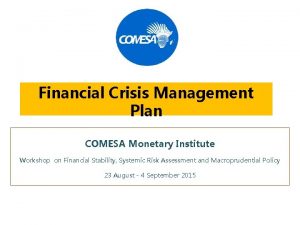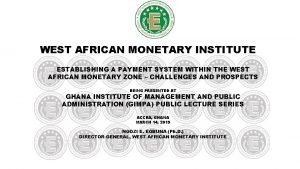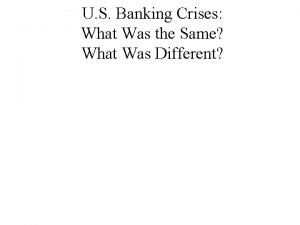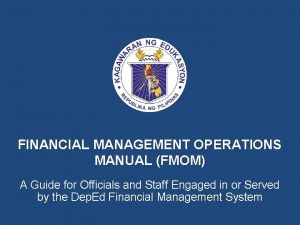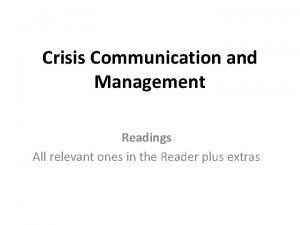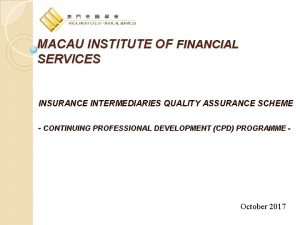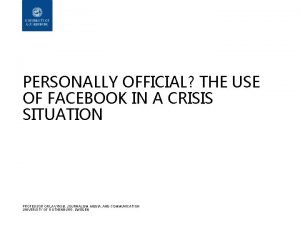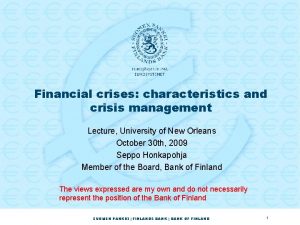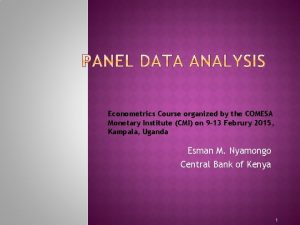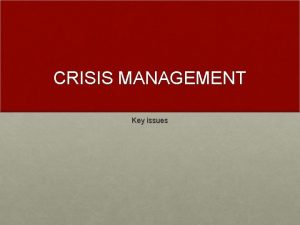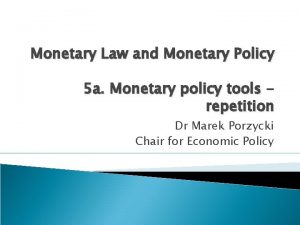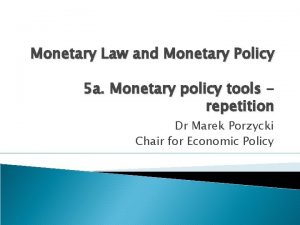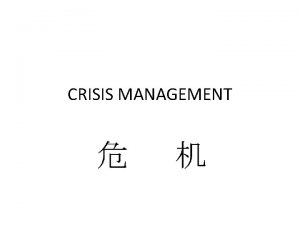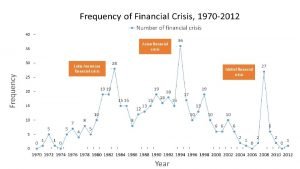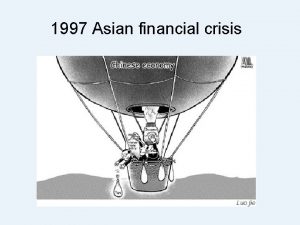Financial Crisis Management Plan COMESA Monetary Institute Workshop























- Slides: 23

Financial Crisis Management Plan COMESA Monetary Institute Workshop on Financial Stability, Systemic Risk Assessment and Macroprudential Policy 23 August - 4 September 2015

Outline • • • Introduction Rationale Financial Crisis Detection Financial Crisis Management Financial Crisis Resolution Conclusion 8/31/2015 Financial Crisis Management Plan 2

Introduction • A financial crisis arises from financial system shocks that are likely to be serious enough to damage the real economy. • The unfolding of a crisis follows a systemic shock, which propagates through the financial system: – financial institutions (including banks, insurance companies, pension funds and securities firms) – Markets – Infrastructure • In the banking sector, it may arise from a shock to a large bank, or many small or medium-sized banks simultaneously. 8/31/2015 Financial Crisis Management Plan 3

Introduction • This Financial Crisis Management Plan provides a framework for the decision-making process in the event of a systemic shock to the banking sector, and provides guidance to staff on: Crisis Detection Crisis Management Crisis Resolution 8/31/2015 Financial Crisis Management Plan 4

Rationale for the plan • The global financial crisis highlighted that many countries were ill-prepared to deal with distress and excessive risk taking in their financial sectors. • Bank of Uganda, with assistance of World Bank, conducted a crisis simulation in 2012 to test the financial crisis preparedness, and identify gaps in financial crises management framework. • One of the recommendations from the exercise was to prepare a ‘Financial Crisis Management Plan’ to facilitate the orderly resolution of a crisis. 8/31/2015 Financial Crisis Management Plan 5

Financial Crisis Detection The main crisis detection channels include: Payments and Settlements • • The Bo. U acts as an “operator” in the payments system and as a result can monitor liquidity pressures arising amongst participants. Director National Payments Systems Department is responsible for informing the Supervision Directorate in case a bank is facing difficultly meeting obligations in the payment system Market Operations • • Bo. U operates in the domestic money and foreign exchange markets on a daily basis, and is in position to identify unusual trading behaviour by banks e. g bidding aggressively for Bo. U liquidity, requests for additional flexibility in its transactions with the Bo. U. Director Financial Markets is responsible for informing the Supervision Directorate when market standing of a bank appears to have deteriorated, or its trading behavior is unusual. 8/31/2015 Financial Crisis Management Plan 6

Financial Crisis Detection Bank Supervision: • Bo. U obtains most of its intelligence about the financial condition of individual banks through the Supervision Directorate, through off-site and on-site reviews directed towards determining financial strength of licensed institutions and their ability to withstand financial and economic shocks. • The Directors in the Directorate must immediately inform Executive Director Supervision when there is a material and immediate threat to a bank’s solvency and doubts exist about the bank’s ability to meet its financial obligations as and when they fall due. Media and the General Public: • • Concerns about the health of a bank could be expressed by members of the public or the media. These concerns should be conveyed by Director Communications to the Executive Director Supervision 8/31/2015 Financial Crisis Management Plan 7

Financial Crisis Detection Other regulatory authorities • Insurance Regulatory Authority (IRA), The Uganda Retirements Benefits Regulatory Authority (URBRA), Capital Markets Authority (CMA) may become aware of a financial threat in the course of exercising their statutory obligations – Need to inform other regulators • Inter-agency cooperation can be achieved through the Financial Sector Surveillance committee (FSSC). 8/31/2015 Financial Crisis Management Plan 8

Financial Crisis Management • Once alerted to the existence of a potential financial crisis, BOU must respond promptly. • Responsibility for financial crisis management ultimately resides with the Governor. • The Executive Director Supervision is responsible for informing the Governor about the existence of a potential financial crisis. • The Governor will discharge this responsibility with the assistance of a crisis management team consisting of Bo. U Financial Stability Committee (FSC) members and specialist staff. • The Governor will also ensure that : – the BOU Board is kept informed of developments and, where appropriate, seek their approval for remedial plans. – keep the Government informed as, and when, appropriate and ensure that the Bo. U also engages with FSSC members. 8/31/2015 Financial Crisis Management Plan 9

Financial Crisis Management Team 8/31/2015 Financial Crisis Management Plan 10

Financial Crisis Management Mandate of Crisis Management Team: 1. Diagnose the exact nature of the crisis, whether it is of technical or operational type, likely to be speedily resolved, or whether it reflects more deep-seated, protraction problems; 2. Determine the systemic implications of the unfolding problems; 3. Assess the liquidity position of any distressed bank; 4. Assess the solvency position of any distressed bank; 5. Consider cross-border implications when foreign-owned banks are involved; 6. Holding actions; 7. Communication strategy. 8/31/2015 Financial Crisis Management Plan 11

Financial Crisis Management Diagnosis • • There should be clear diagnosis of the problem: a clear summary of what has happened and exactly which institutions are involved. There is a wide range of reasons which prompt a financial crisis at one or more banks including: – – • Rapid deterioration in financial health of a bank; News of a large unexpected loss; Operational problems including systems-related issues; Loss of confidence due to contagion from other distressed financial institutions. The Executive Director Supervision will provide the crisis management team with a summary of known facts and a summary of the distressed bank(s) liquidity and solvency positions. 8/31/2015 Financial Crisis Management Plan 12

Financial Crisis Management Systemic Impact • To assess whether the problems of bank have the potential to inflict damage on the financial system and, ultimately the wider economy • Whethere any signs of contagion within the financial system – Larger than usual deposit outflows – Discrimination within wholesale funding markets – Abnormal payment flows • Assessing the systemic importance of a bank will be informed by: – size; – substitutability; – interconnectedness. 8/31/2015 Financial Crisis Management Plan 13

Financial Crisis Management Liquidity Assessment • This will determine the ability of the bank to meet its obligations as and when they fall due. The adequacy of liquid assets; Expected cash flows for at least the next 30 days; Availability of confirmed funding lines; If foreign-owned, the prospect of immediate liquidity support for the Ugandan bank from the parent bank. – Liquidity pressure points within the maturity profile of assets and liabilities over a longer time frame; – Scope for access to funding across different markets. – – 8/31/2015 Financial Crisis Management Plan 14

Financial Crisis Management Solvency Assessment • Assessment of the bank’s net worth with regard to: – Recent and prospective trends in the level of loan impairments both for the individual bank and for the banking industry more generally; – The recent pace of write-offs at the bank and within the industry more generally. • Conservative assumptions will be applied to the valuation of assets and liabilities. Worst case scenarios will be considered in the economic outlook. 8/31/2015 Financial Crisis Management Plan 15

Financial Crisis Management Cross-border considerations • If the distressed bank is foreign owned there is a need to consider ‘ring fencing’ the local bank to stop lending to the parent bank or the repatriation of capital overseas. This can be achieved using Bo. U’s intervention powers under Section 82 of the Financial Institutions Act 2004 which includes a cease and desist order. • EDS will also need to contact the home regulator of the distressed bank to brief them on developments and to determine the prospect of parent bank support for the Ugandan bank. • If the crisis involves a Ugandan bank that operates overseas, EDS has a responsibility to inform the foreign financial regulator at the earliest opportunity. 8/31/2015 Financial Crisis Management Plan 16

Financial Crisis Management Holding actions Immediate steps the Bo. U can take to limit potential for further deterioration: • Withhold any distributions to shareholders; • Withhold payments to related parties unless approved by Bo. U; • Not enter into any new credit obligations without approval; • Remove directors or senior management identified as an impediment to investigations or contributor to existing problems. Communication Strategy It is essential from the outset that a strategy be developed to handle communications with the media. The media strategy should incorporate the following broad principles: • The objective of public communication should be clear; • Where possible, avoid definitive public statements until facts are known; • Where possible, release ‘bad news’ with the ‘good news’; • Pre-positioning by FSSC agencies with material ready for placement on agency website at short notice. 8/31/2015 Financial Crisis Management Plan 17

Financial Crisis Resolution • • • Resolution options should facilitate both “open” and “closed” resolution outcomes Resolution may be achieved with liquidity support, or restructuring involving Government Support The choice of resolution tools will be determined based on the criteria of systemic risk and solvency. Scenarios I and II – A liquidity crises as the distressed banks are otherwise sound. Scenario III – Insolvent but not systemically important. Scenario IV – Systemically important but in deep financial trouble. 8/31/2015 Financial Crisis Management Plan 18

Financial Crisis Resolution Liquidity Support • • The Bo. U provide short-term liquidity support to solvent banks through allowing banks to borrow up to 25 percent of required reserves for 3 months, or rediscount its Treasury securities with less than 91 days to maturity at BOU Banks may also borrow for longer periods not exceeding fifteen years if they have eligible collateral. • Where a bank is judged insolvent and systemically unimportant (Scenario III), requests for liquidity support beyond Bo. U facilities should be declined, consistent with the overriding objective of minimising ‘moral hazard’ in the financial system • Where a bank is potentially insolvent but systemically important Bo. U may provide emergency liquidity assistance but subject to Ministerial approval and lodgement by the Government of sufficient funds or debt securities to cover the advance in full. 8/31/2015 Financial Crisis Management Plan 19

Financial Crisis Resolution Closed resolution • • • A “closed resolution” outcome is where the bank is closed to new business and wound-up with depositors either paid out or transferred to another bank. If a bank is insolvent and cannot be restored to solvency then under Financial Institutions Act (Section 94) Bo. U may close the bank and place it under receivership. Under receivership Bo. U may choose to liquidate the assets of the institution. The resolution tool is appropriate for non-systemic banks. Deposit Protection Scheme • • • In case of liquidation, depositors must be paid promptly by the Deposit Protection Fund (DPF) since delays may further undermine confidence in the financial system and add to contagion. The DPF covers depositors up to USh. 3 million per depositor per bank. The Financial Institutions Act requires payment within 90 days. The Director Non-Bank Financial Institutions at Bo. U coordinates insured deposits payout. 8/31/2015 Financial Crisis Management Plan 20

Financial Crisis Resolution Open resolution • An “open resolution” is an outcome in which a distressed bank is enabled to meet its existing obligations and its core functionality is retained. • This is the preferred resolution option if a distressed bank is systemically important. • Bo. U may approach the Minister of Finance, Planning and Economic Development (Mo. FPED) for support to resolve the a systemically important insolvent bank , to preserve those parts of the business that provide vital services to the financial system and the wider economy, which would cause system-wide damage if lost. 8/31/2015 Financial Crisis Management Plan 21

Conclusion and way forward • There should be quick resolution of financial crisis, so as to maintain confidence in the banking system. • Coordination with other financial sector regulators and Mo. FPED in resolution is important to avoid financial sector regulators working at cross purposes. • The crisis plan will continue to be reviewed and updated as the financial crisis management framework at Bo. U is enhanced. – Expanding the scope to financial sectors other than the banking sector, to include: insurance, capital markets and pensions. 8/31/2015 Financial Crisis Management Plan 22

Thank You 8/31/2015 Financial Crisis Management Plan 23
 Financial crisis management plan
Financial crisis management plan George washington crisis management
George washington crisis management West african monetary institute
West african monetary institute Cholinergic crisis
Cholinergic crisis International monetary and financial environment
International monetary and financial environment International financial environment
International financial environment Walmart crisis management plan
Walmart crisis management plan Asian financial crisis
Asian financial crisis Showa financial crisis
Showa financial crisis Financial management operations manual 2016 pdf
Financial management operations manual 2016 pdf Wrap crisis plan examples
Wrap crisis plan examples Laetitia lagneau
Laetitia lagneau Crisis managment plan
Crisis managment plan Macau institute of financial services
Macau institute of financial services Deemed disposition
Deemed disposition Business plan writing workshop
Business plan writing workshop Reactive phase of crisis management
Reactive phase of crisis management Ikea crisis management
Ikea crisis management Crisis management team responsibilities
Crisis management team responsibilities Ford and firestone crisis management
Ford and firestone crisis management Crisis management handbook
Crisis management handbook Crisis management
Crisis management Characteristics of crisis management
Characteristics of crisis management Crisis management assignment
Crisis management assignment
